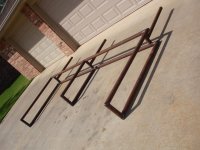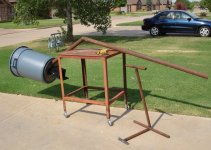well I'm at it- thoughts on this Lincoln AC225 from NT? looks like a good deal for the $$$
Lincoln Electric AC-225 Arc Welder, Model# K1170 | Arc Welders | Northern Tool + Equipment
There's nothing wrong with the Lincoln AC-225, but as Erik pointed out, AC/DC is a better way to go. You have more choices for welding rods to use, and a smoother, better controlled arc. The price increase is indicative of how much better it is.
Incidentally, your Dad may be correct about starting with the MIG. I started with a Miller 135 MIG about 6 years ago, upgraded to a Miller 180 MIG (with spoolgun for aluminum), and picked up a well-used Century AC/DC stick machine 2 years ago. I think I've used the stick on the AC setting once, just to see what it was like.
I'd recommend getting either a 110v or 220v MIG to start with, and start looking for a good used stick machine for heavier materials.
Up to 1/2 inch material, the 230/140 amp AC/DC welder I have will do just fine. Duty cycle isn't so much of an issue for most of us that don't weld for a living. After all the projects I've built using my welders, none have ever exceeded the duty cycle and shut down. The 135 was 20%, the 180 is 30%, and the stick varies depending on the setting, but it's comparable to the other two.
You don't need 70% duty cycles and 300+ amps, contrary to popular TBN belief. It's easy to spend somebody else's money here.
My reasons for starting with the MIG are simple, being that they are EASY to weld with... a monkey can run a decent bead using a MIG, at least I can..
Once you have the hang of watching the puddle to control the weld, you can easily adapt that basic knowledge to using a stick, which adds the complication of maintaining arc length and moving the holder as the rod gets shorter.
A MIG will easily weld thin materials, like body metal and chainsaw mufflers. The stick will look after heavy stuff from about 1/8 inch and up. I use both in a typical fabrication job, quite often things get tacked with the MIG, then finished with the stick. Or if I get lazy the MIG does the whole job.
Repair work is the real forte of the stick, you can weld rusty, dirty metal with the right rods, and wind isn't an issue either. The MIG is better suited to shop work on new material, although flux core wire can be used for most applications if you want.
As the thread develops more, you'll see how opinionated people are about their welding preferences. It's like asking which is better, John Deere or Kubota..:laughing:
Sean


